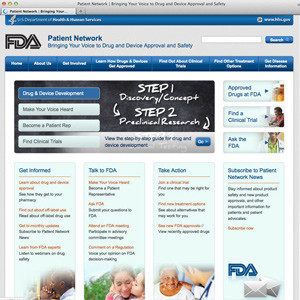 The Food & Drug Administration (FDA) launched its new website for and about patients, the Patient Network, with the tagline, “Bringing your voice to drug and device approval and safety.”
The Food & Drug Administration (FDA) launched its new website for and about patients, the Patient Network, with the tagline, “Bringing your voice to drug and device approval and safety.”
With this move, the FDA moves toward social health, someplace where at least one-third of U.S. consumers already opine, shop, share personal info, crowdsource cures, and support each other on all-matters-health-and-illness.
The objective of the Patient Network is, “to help FDA help patients have a bigger voice.” Dr. Margaret Hamburg, the Commissioner of the FDA, talks about the concept here.
The rationale? “When patients better understand the intricacies of how medical products are studied, reviewed, assessed and brought to market,” she writes in her blog post, “their input will be that much more focused and valuable. We hope, with the launch of this new web site, to expand the role of patients beyond the select group of patient representatives and to engage a wider audience of patients in new and broader ways.”
The FDA is recruiting Patient Representatives to serve on the 50-some advisory groups. Patients will offer their personal perspectives on medications and devices and their patient journeys, as well as consult and present at hearings.
A video on the site further explains:
The application page for becoming a Patient Rep is here.
Health Populi’s Hot Points: This FDA development signals a kind of tipping point for recognizing the Power of Patients in the U.S. health system. That the most powerful health regulator in the world is bringing patients into the regulatory regime — cleared by the nation’s attorneys — means that the patient voice will be incorporated into decisions about new products and innovations that come into the FDA’s in-box for approval. This is a welcome move for U.S. health citizens who have been long frustrated by the lack of user/patient-centered design in health products, and consumer safety and protection for themselves and loved ones.
This also heralds the regulator’s embrace of shared decision making in health care, recognizing the central role of the patient/consumer in health. This is the mission of the Society for Participatory Medicine (#S4PM), an organization of which I’m a member. For more information on the Society, visit the website at: http://participatorymedicine.org/




 Thank you FeedSpot for
Thank you FeedSpot for